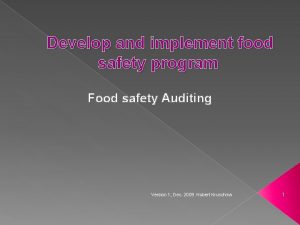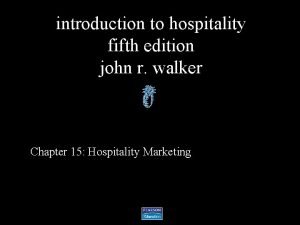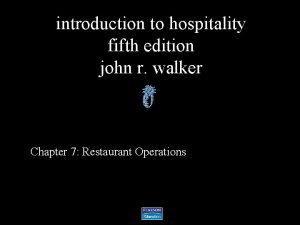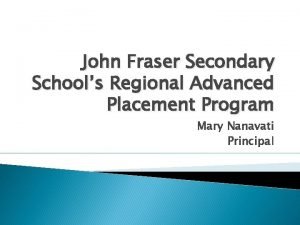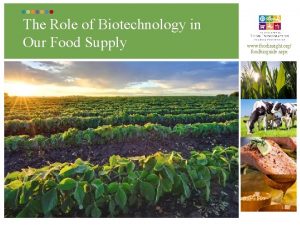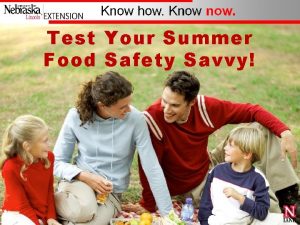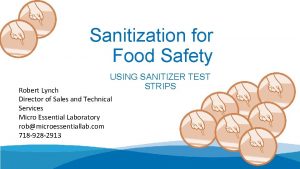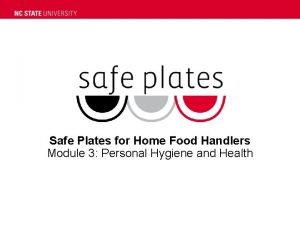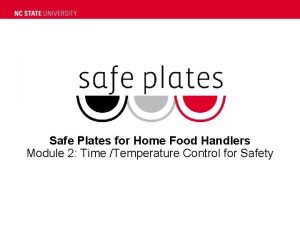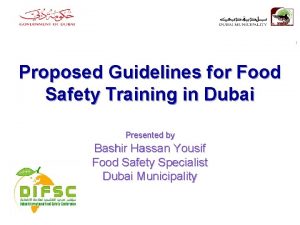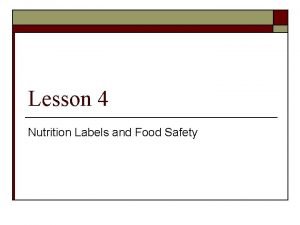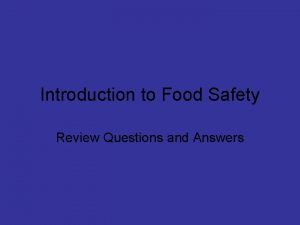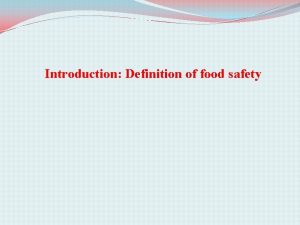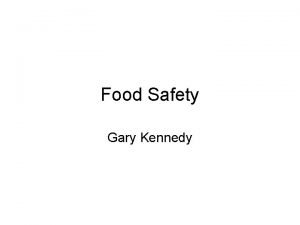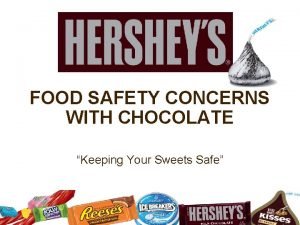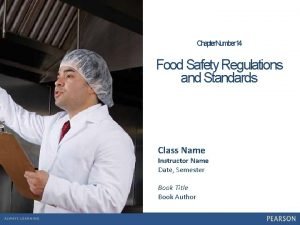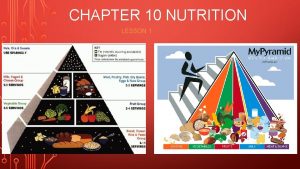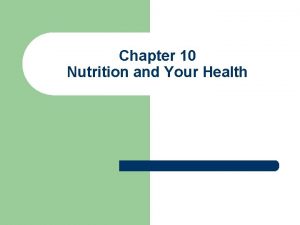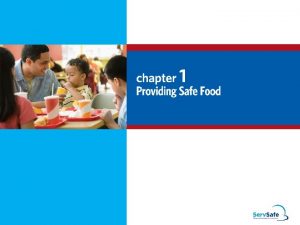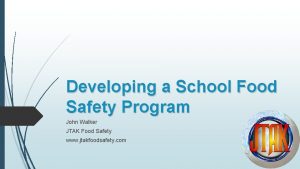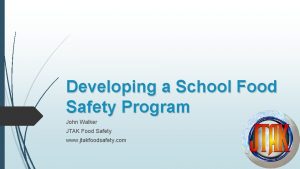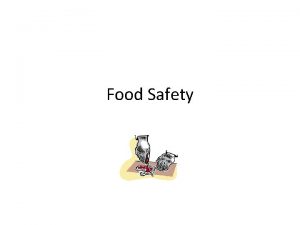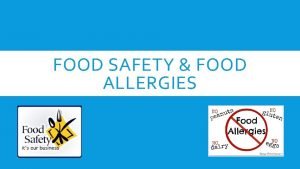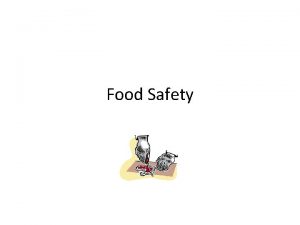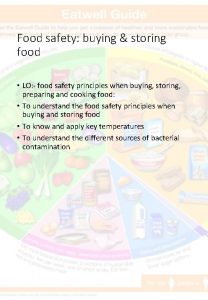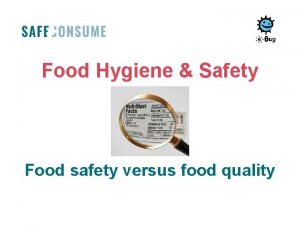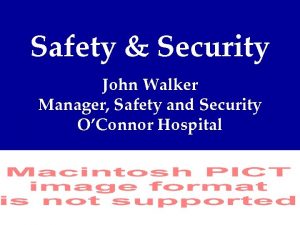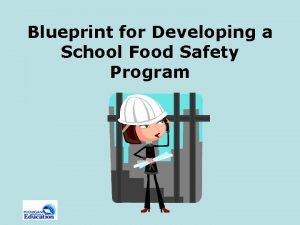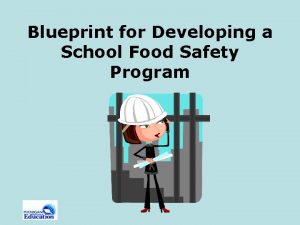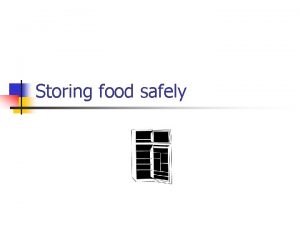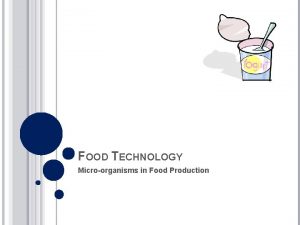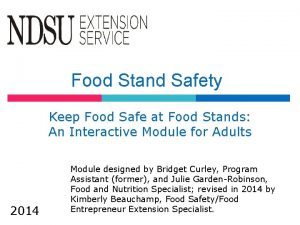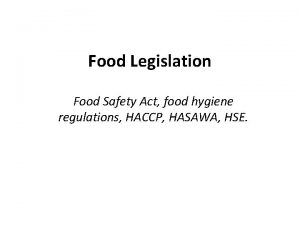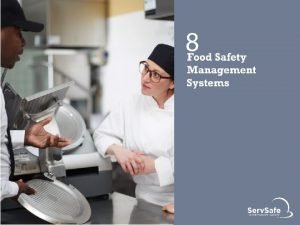Developing a School Food Safety Program John Walker
































- Slides: 32

Developing a School Food Safety Program John Walker JTAK Food Safety www. jtakfoodsafety. com

Objectives Regulation HACCP and its principles Process Approach Standard Operating Procedures (SOPs) Developing your Food Safety program

The Requirement Ø The Child Nutrition and WIC Reauthorization Act of 2004 requires school food authorities (SFAs) to implement a food safety program for the preparation and service of school meals served to children in the school year beginning July 1 st, 2005. Ø The program must be based on Hazard Analysis and Critical Control Point (HACCP) principles and conform to guidance issued by the Department of Agriculture (USDA). Ø All SFAs must have a fully implemented food safety program that complies with HACCP principles or with this optional guidance no later than the end of the 20052006 school year.

What? HACCP is a food safety management system Proactive vs Reactive Minimize risk of hazards in a food preparation process Food manufacturers vs retail food Process Approach developed by FDA (for retail food)

Highly Susceptible Populations "Highly susceptible population" means PERSONS who are more likely than other people in the general population to experience foodborne disease because they are: (1) Immunocompromised; preschool age children, or older adults; and (2) Obtaining FOOD at a facility that provides services such as custodial care, health care, or assisted living, such as a child or adult day care center, kidney dialysis center, hospital or nursing home, or nutritional or socialization services such as a senior center How much difference in immune system between a 4 year old and a 6 year old?

HACCP First developed for the Apollo space program Pillsbury, US Army Labs, and NASA Required now for certain food processors (juice, seafood, meat a& poultry) FSMA will make required for all food processors in future (HARPC)

Food Safety Program Written plan for each individual school (similar operations) Based on HACCP principles Include Sanitation Temperature control Standard Operating Procedures (SOPs)

Definitions Hazard Analysis – Review a process to determine risks Control Measures – Result in risk reduction Critical Control Points (CCPs) – Step in a process that is essential to food safety Critical Limits – Measurable parameter, usually time and/or temperature Process Approach – Method of grouping menu items into 3 separate categories Standard Operating Procedure (SOP) – Written instructions for a food service task to reduce food safety hazards

Types of Hazards specific to the preparation of the food Non-specific hazards that affect all foods Biological Chemical Physical A good food safety management program controls both Specific and Non-specific hazards

Standard Operating Procedures (SOPs) Pre-requisite program Foundation of HACCP Step by Step written instructions for routine food service tasks Some templates provided by USDA, NFSMI, ADEC

Other Prerequisite Programs Employee training Preventive Maintenance Employee illness policy Supplier/Vendor requirements Food Allergen program

SOPs needed Including but not limited to: Personal hygiene Employee illness Receiving Transport Cleaning & Sanitizing Temperature Monitoring Thawing, Cooking, Cooling, & Reheating

Principles of HACCP Hazard analysis Critical Control Points Critical Limits Monitoring Corrective Actions Verification/Validation Recordkeeping/Documentation These principles are built into the Process Approach

Assemble your team

Process Approach All menu items can be lumped together in 3 broad categories Food kept cold from preparation through service Prepared hot and served the same day hot Food prepared hot and served cooled, or possibly reheated.

Process Flow Diagrams A map of the sequence of steps followed to prepare a menu item (or group of menu items) Can be used for groups of recipes Receive Store Prep Serve

Identifying Critical Control Points USDA recipes provide some Critical Control Points Cooking Hot Holding Cooling Perform a hazard analysis on each step in your process to identify high risk hazards and where in the process they can be controlled.

Process #1 – No Cook Cold holding temperature Time as a public health control

Process #2 – Same Day Service Cooking Hot holding Time as a public health control

Process #3 – Complex Food Preparation Cooking Cooling Hot or cold holding Time as a public health control Reheating for hot holding

Grouping Exercise

Critical Limits A critical limit is a boundary which separates safe food from unsafe food. A measurable value, such as time and/or temperature

Same CCP, different CL

Monitoring Planned observation and documentation of Critical Limits What should be monitored When should the monitoring take place How to measure (what equipment to use) Who should be doing the monitoring

Corrective Actions to take if a critical limit is not met (or exceeded) Pre-determined actions should be included in your HACCP plan Always two parts to a corrective action: How do we keep unsafe food from being served to our students? How do we fix the root cause of the problem? Don’t be afraid to use and document corrective actions!

Recordkeeping What records are we generating in this HACCP plan? How did we develop the HACCP plan (HACCP team, written hazard analysis, selection of CCPs) You can use pre-existing records Receiving temperature on invoice Production log

Types of Records documenting SOPs Time and temperature monitoring records Corrective action records Calibration records Training logs Receiving logs Verification or review of records


Verification/Validation These activities help us confirm that our HACCP plan is working How do I know my thermometer is right? Management review of records Any reoccurring issues? Review and revise HACCP plan at least annually New equipment New menu items Inspection results

Employee training Initial training On-going training throughout the school year Annual training on food safety principles New hire training, including substitutes and volunteers Maintain training records

For more information SOP templates NFSMI SOP templates - http: //www. nfsmi. org/Resource. Overview. aspx? ID=75 NFSMI SOP creator - http: //sop. nfsmi. org/ ADEC Active Managerial Control (includes Wizard) http: //dec. alaska. gov/eh/fss/Food/AMC_Home. html USDA Guidance http: //www. nfsmi. org/resourceoverview. aspx? ID=57

Questions, Comment, Concerns? John Walker JTAK Food Safety PO Box 3606 Soldotna, AK 99669 john@jtakfoodsafety. com www. jtakfoodsafety. com
 Food safety food security
Food safety food security Develop and implement a food safety program
Develop and implement a food safety program Introduction to hospitality marketing
Introduction to hospitality marketing Tourism the business of hospitality and travel 5th edition
Tourism the business of hospitality and travel 5th edition John r walker introduction to hospitality management
John r walker introduction to hospitality management Unit 2 food food food
Unit 2 food food food Food chain food chain food chain
Food chain food chain food chain John fraser ap program
John fraser ap program Walker valley high school band
Walker valley high school band Hilda walker school
Hilda walker school Safety depth formula in ecdis
Safety depth formula in ecdis Safety care certification
Safety care certification Process safety vs personal safety
Process safety vs personal safety Ind safety report
Ind safety report Basic safety (construction site safety orientation)
Basic safety (construction site safety orientation) Basic safety construction site safety orientation
Basic safety construction site safety orientation Foodinsight.org
Foodinsight.org Savvy food safety
Savvy food safety Test strips for food safety
Test strips for food safety Raleigh module 3
Raleigh module 3 Tcs food
Tcs food Health and safety management system template
Health and safety management system template Food hygiene training in dubai
Food hygiene training in dubai Lesson 4 nutrition labels and food safety
Lesson 4 nutrition labels and food safety Introduction to food safety answers
Introduction to food safety answers Definition of safe food
Definition of safe food Four steps to food safety
Four steps to food safety Gary kennedy food safety
Gary kennedy food safety Chocolate food safety
Chocolate food safety Food safety regulations and standards
Food safety regulations and standards Chapter 10 lesson 4 nutrition labels and food safety
Chapter 10 lesson 4 nutrition labels and food safety Chapter 10 lesson 4 nutrition labels and food safety
Chapter 10 lesson 4 nutrition labels and food safety Tcs in food safety
Tcs in food safety

